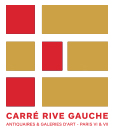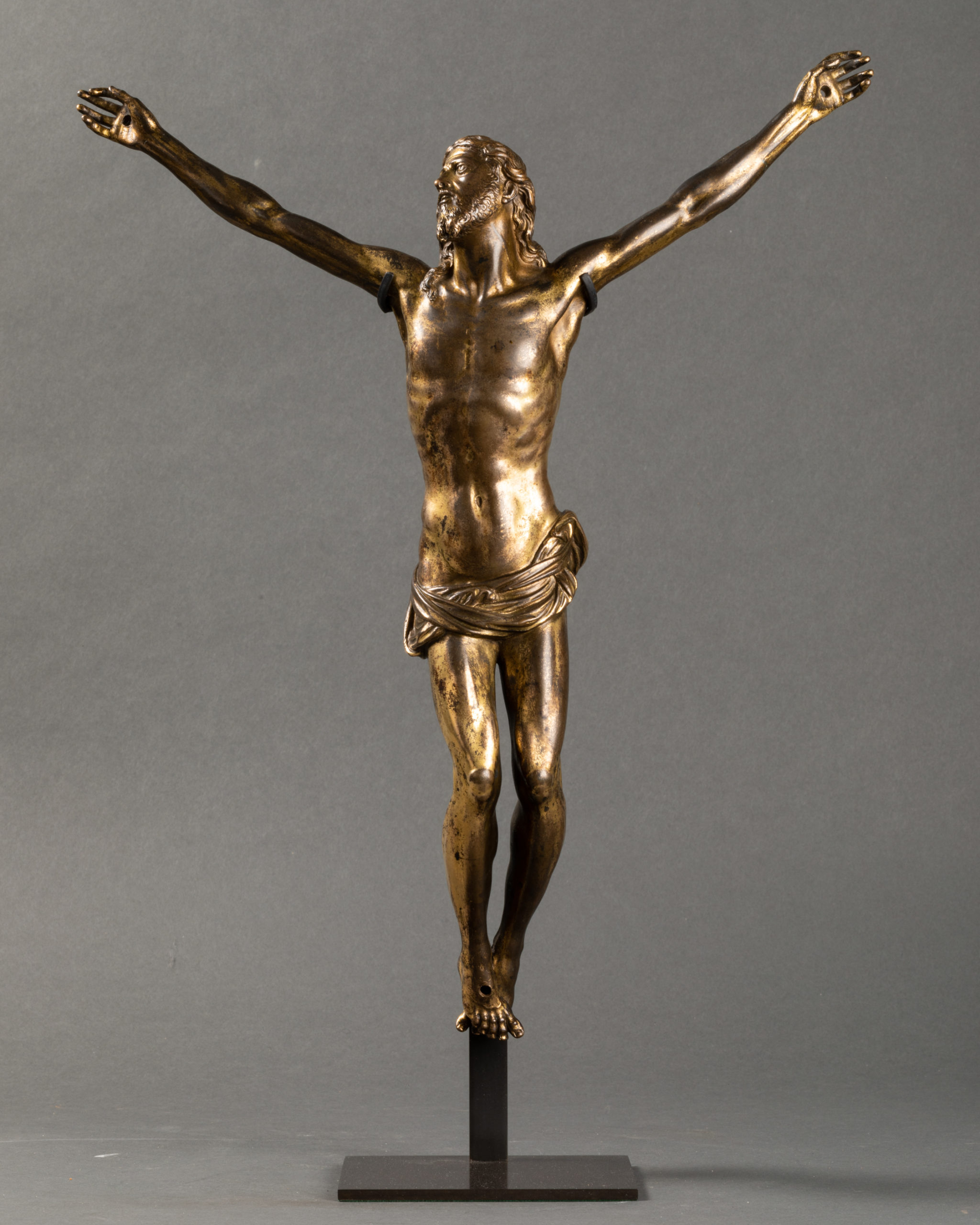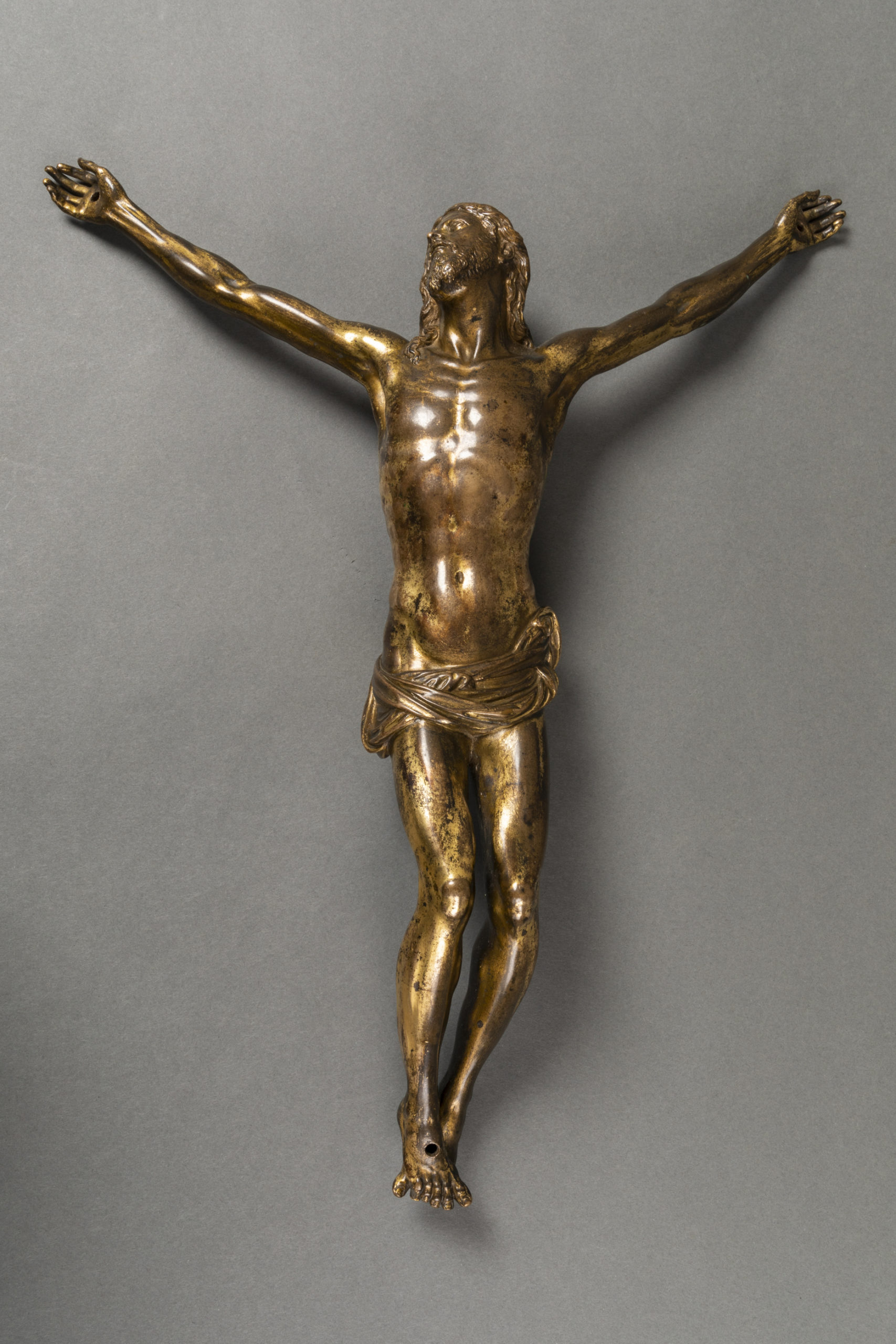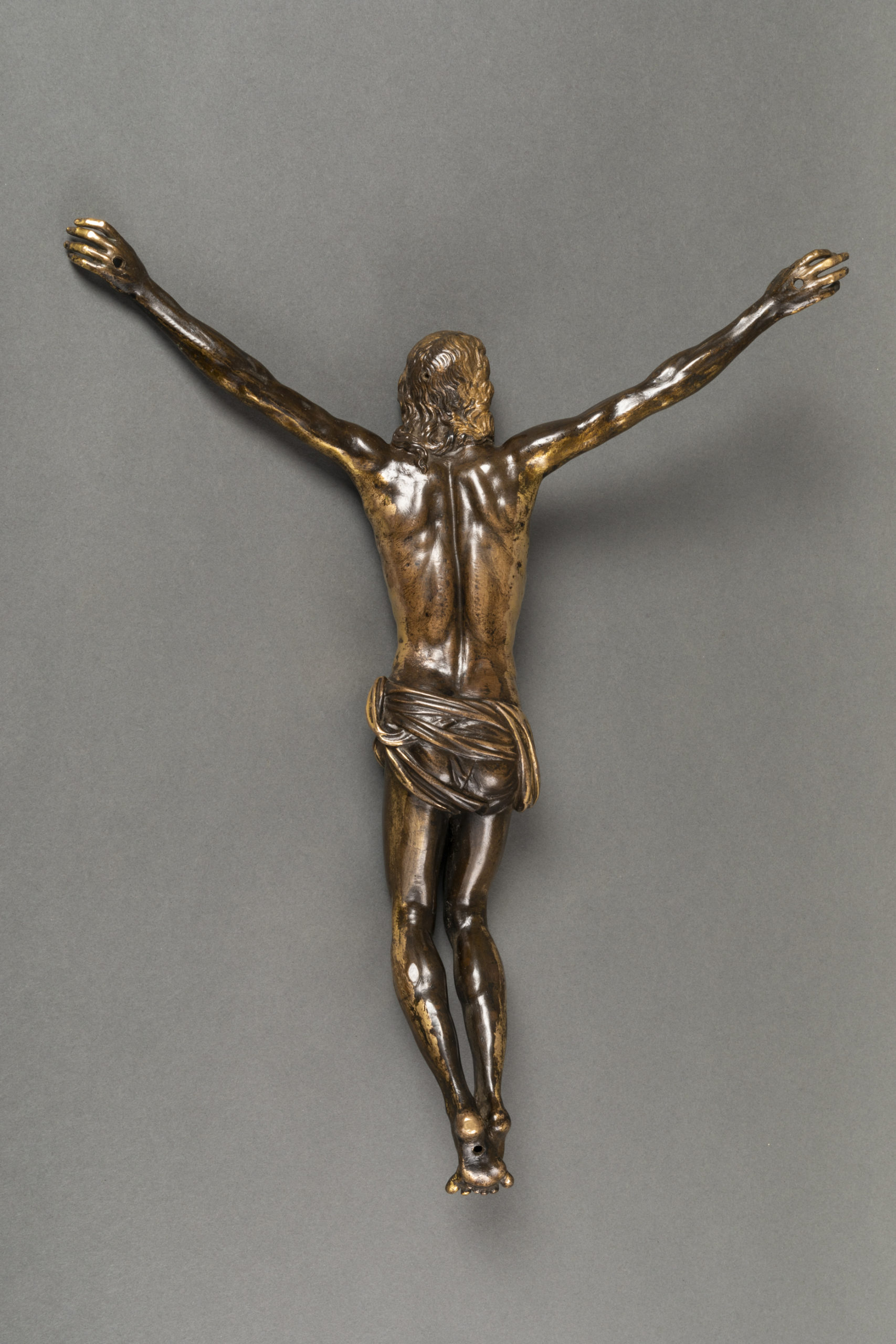Description
Ce splendide Christ a été réalisé en Toscane, Italie, à l’orée du XVIIe siècle.
Le travail du bronze confère au Christ un aspect physique idéalisé, notamment permis par la grande précision et profusion des détails. Une attention particulière est portée à la ciselure des cheveux, de la barbe et des traits du visage qui relève d’une grande sensibilité plastique. Malgré les côtes saillantes du Christ, la torsion du corps épuisé et la tension de ses muscles à l’agonie, une réelle sérénité se dégage de cette oeuvre. Dépouillé de tout caractère divin, pour n’être plus qu’un homme, le Christ n’est vêtu que du traditionnel périzionum, au drapé à forts plis, laissant une hanche découverte.
Cette pièce est à rapprocher du corpus du plasticien Giambologna (1529-1608). Né Jehan de Boulongne (en flamand) ou Jean de Bologne ou Boulogne (en français) à Douai en 1529, il réalise son apprentissage auprès du sculpteur Jacques du Brouecq (1505v.- 84) dans les Flandres. Vers 1555, il part en Italie, où il est alors appelé Giovanni Bologna (contracté postérieurement en Giambolonia). Artiste complet, à la fois créateur de modèles sculpturaux et iconographiques, il réalise un large corpus de «Corpora Christi». Le vif succès que connurent ses oeuvres est notamment dû à son école. En effet, le plus vraisemblable serait que Giambologna soit à l’origine des modèles initiaux, dessinés puis parfois créés en grand format, et exécutés ensuite par ses élèves, ou successeurs, en petits formats destinés à être offerts, en tant que cadeaux diplomatiques par exemple (notamment par les Médicis). Cette délégation de la production à son atelier, permit de diffuser ses modèles, réalisés en nombre plus important, en particulier à la fin du XVIe et la première décennie du XVIIe siècle. Certains membres de cet atelier se démarquèrent, et connurent une certaine notoriété. C’est notamment le cas d’Antonio Susini qui y travailla dès 1570 et à qui un grand nombre de coulage est attribué.
Comme dit précédemment, Giambologna ne se contente pas de créer des figures plastiques emblématiques, il conçoit également des sujets. Il entame sa production avec le modèle d’un « Cristo Morto », présentant le Christ mort, la tête baissée en signe d’affliction, en référence au passage biblique « Mon Dieu, mon Dieu, pourquoi m’as-tu abandonné ? » (Matthieu 27:45, Marc 15:34). Il s’agit de la représentation favorisée à la fin du Moyen-Âge, alors que les siècles précédents, et ce dès les premières représentations du Jésus en croix au VIe siècle, avaient privilégiés un Christ encore conscient, sans douleur, avec les yeux ouverts, mais regardant vers le spectateur et rarement tournés vers le ciel. La rupture avec cette tradition a lieu à l’occasion de la réalisation d’un dessin de Michel-Ange, vers 1540, pour Vittoria Colonna, conservé au British Museum, Londres. Jésus-Christ y est alors présenté soucieux, implorant le ciel mais bien vivant et le visage tourné vers le ciel.
C’est dans la continuité de ce nouveau modèle que Giambologna créa son « Cristo vivo » vers 1590. Il abandonne l’aspect pathétique afin de lui conférer une nouvelle grandeur, celle de l’acceptation, telle qu’elle est retranscrite dans l’évangile selon Saint Luc (23:46) : « Père, entre tes mains je remets mon esprit ! ». Le fils de Dieu est alors représenté libéré de toute souffrance s’offrant à la volonté de son divin Père, vers qui son regard est tourné, et apaisé par la connaissance de sa résurrection.
De plus, cette évolution du sujet est étroitement liée à son contexte de création. En effet, le concile de Trente eut une grande détonation dans le monde des arts, obligeant les artistes à réviser leurs créations, afin de les adapter aux nouveaux préceptes religieux que favorisait le concile. Parmi eux, l’importance renouvelée du mystère l’incarnation et de l’assurance d’un bonheur céleste éternel permit par la résurrection est primordiale, nécessitant de nouvelles images pour le célébrer. Le travail de Giambologna et son atelier est particulièrement démonstratif de ces interrogations théologiques, où le spectateur doit être convié à partager la béatitude christique et cette méditation divine, selon le modèle de « l’Imitatio Christi ».
Seul deux versions du « Cristo Vivo » ont été attribuées avec certitude au maître, ou son atelier proche. L’un est conservé au monastère des Descatras Reales de Madrid et le second a été vendu par la maison de vente Sotheby’s le 9 juillet 2004 (lot 7). La qualité de notre pièce ne laisse aucun doute sur sa proximité avec l’atelier de Giambologna. Notre Cristo Vivo serait certainement dû à une production réalisée par l’un de ses successeurs, sur le modèle de l’artiste, exemple concret du rayonnement ainsi que du succès que connut cette figure. De plus, ce modèle de référence transcende le monde sculptural pour s’imposer dans celui de la peinture, comme le prouve le corpus de crucifixion de Guido Reni.
This splendid Christ was made in Tuscany, Italy, at the beginning of the 17th century. The bronze work gives the Christ an idealized physical appearance, particularly due to the great precision and profusion of details. Particular attention is paid to the chiselling of the hair, beard and facial features, which are of great plastic sensitivity. Despite the protruding ribs of Christ, the twisting of the exhausted body and the tension of his dying muscles, a real serenity emerges from this work. Stripped of all divine character, to be only a man, Christ is dressed only in the traditional perizonum, with a strongly folded drape, leaving one hip uncovered.
This piece can be compared to the corpus of the plastic artist Giambologna (1529-1608). Born Jehan de Boulongne (in Flemish) or Jean de Bologne or Boulogne (in French) in Douai in 1529, he completed his apprenticeship with the sculptor Jacques du Brouecq (1505v.-84) in Flanders. Around 1555, he leaves for Italy, where he is then called Giovanni Bologna (later contracted in Giambolonia). A complete artist, at the same time creator of sculptural and iconographic models, he produced a large corpus of « Corpora Christi ». The great success of his works is due in particular to his school. Indeed, it is most likely that Giambologna was at the origin of the initial models, drawn and then sometimes created in large format, and then executed by his students, or successors, in small formats intended to be offered as diplomatic gifts for example (notably by the Medici). This delegation of the production to his workshop allowed the diffusion of his models, made in greater numbers, especially at the end of the 16th and the first decade of the 17th century. Some members of this workshop stood out and became well known. This is notably the case of Antonio Susini, who worked there from 1570 and to whom a large number of casts are attributed.
As previously mentioned, Giambologna not only created emblematic plastic figures, he also designed subjects. He begins his production with the model of a « Cristo Morto », presenting the dead Christ, with his head bowed in affliction, in reference to the biblical passage « My God, my God, why have you forsaken me? (Matthew 27:45, Mark 15:34) The Bible passage « My God, my God, why have you forsaken me? (Matthew 27:45, Mark 15:34) This was the representation favored in the late Middle Ages, whereas previous centuries, from the earliest representations of Jesus on the cross in the sixth century, had favored a Christ who was still conscious, painless, with his eyes open but looking up at the viewer and rarely turned toward heaven. The break with this tradition took place on the occasion of a drawing by Michelangelo, around 1540, for Vittoria Colonna, preserved in the British Museum, London. In it, Jesus Christ is presented worried, imploring heaven, but alive and with his face turned towards heaven.
It is in the continuity of this new model that Giambologna created his « Cristo vivo » around 1590, abandoning the pathetic aspect in order to give it a new greatness, that of acceptance, as it is transcribed in the Gospel according to Saint Luke (23:46): « Father, into your hands I commend my spirit! ». The Son of God is then represented free from all suffering, offering himself to the will of his divine Father, to whom his gaze is turned, and appeased by the knowledge of his resurrection.
Moreover, this evolution of the subject is closely linked to his context of creation. In fact, the Council of Trent had a great detonation in the world of the arts, forcing artists to revise their creations in order to adapt them to the new religious precepts promoted by the Council. Among them, the renewed importance of the mystery of the Incarnation and of the assurance of eternal heavenly happiness made possible by the resurrection is paramount, requiring new images to celebrate it. The work of Giambologna and his workshop is particularly
demonstrative of these theological questions, where the spectator must be invited to share the Christic beatitude and this divine meditation, according to the model of the « Imitatio Christi ».
Only two versions of « Cristo Vivo » have been attributed with certainty to the master, or his nearby workshop. One is kept at the Monastery of the Descatras Reales in Madrid and the second was sold by the Sotheby’s auction house on July 9, 2004 (lot 7). The quality of our piece leaves no doubt about its proximity to Giambologna’s workshop. Our Cristo Vivo would certainly be due to a production carried out by one of his successors, on the model of the artwork of Giambologna. In addition, this reference model transcends the world of sculpture to impose itself in the world of painting, as Guido Reni’s crucifixion corpus proves.




